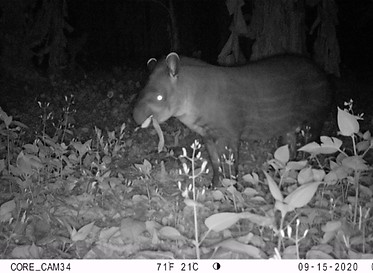
MONITORING
REGUA continuously monitors biodiversity and has partnerships with several researchers from different universities. There are two main areas of fauna monitoring in the reserve; the monitoring of the response of the fauna to the restoration actions and the integrated monitoring of the use of the trails by the fauna. Permanent plots are being implemented and will be monitored on a regular basis through trap cameras.

One of the monitoring programmes is carried out by Dr. Manoel Muanis, biologist with a master's degree in Mastozoology and a PhD in Ecology from UFRJ, through the Earthwatch Institute programme. REGUA has been monitoring the response of mammal populations to reforestation since 2019 with the participation of citizen science volunteers. Anyone interested in science and ecology can come to REGUA for a week or two and volunteer in this monitoring project and help fund the research. More information can be obtained on the project website:
https://earthwatch.org/expeditions/wildlife-and-reforestation-brazil
The main activities of this project include the collection and measurement of small mammals in live-traps and the installation and monitoring of automatic cameras. In addition, volunteers help with the collection of vegetation growth monitoring data, which is used for calculating sequestered carbon and also in REGUA's reforestation activities.
No Legend - (Waiting for the Files)
Additional monitoring is carried out by the resident researcher Dr. Jorge Bizarro with a focus on butterflies, running once a week, throughout the year, on four trails in the following: week 1- Yellow Trail / week 2 - Brown Trail / week 3 - Fragmento Onofre Cunha / week 4 - Violet Trail. The sectors are between 1.7 and 3 km long and take an average of an hour and a half to carry out the monitoring. On each walk, the number of butterflies seen is recorded and, whenever possible, the species of the individuals seen is identified, using only a pair of binocular as an auxiliary tool. This work will make it possible to better quantify the local population of butterflies, the areas where certain species are more frequent and thus have data that increases the effectiveness of offering the activity of observation and photography of these wonderful insects to guests and visitors.

No Legend - (Waiting for the Files)

No Legend - (Waiting for the Files)
We have a third monitoring programme that focuses on Lowland Tapirs, which consists of field trips to collect images from camera traps. Tapir monitoring is also carried out with radiotelemetry collars on introduced individuals, which allow tracking of their location after they are released, this information enables us to quantify the adaptation of the animals to the new environment. In addition, the tapirs' ecological relationships in the forest are also monitored by the @lemasifrj. These studies include diet and seed dispersal, interactions with dung beetles, relationship with vegetation structure, soil compaction and tick density. The objective is to verify the effect of the presence of tapirs in the environment and to understand the interactions that they establish with the other inhabitants of the forest. Currently, the network of cameras (about 40) are spread around the tapir release areas and close to the acclimatisation pens. The REFAUNA and ANTologia teams monitor this.
Further monitoring takes place by students who come to REGUA to work specifically with camera traps in order to monitor REGUA's big cats. Hugo Anselmo, from the University of Porto, is committed to seeking answers about the behaviour of pumas, which inhabit the highest and most well-preserved parts of the forest in REGUA and PETP. He is accompanied by his advisor Nuno Monteiro from Portugal, and is co-supervised by researcher André Lanna, who completed his doctorate with Southern Muriquis here at REGUA. We also have student Yan Gonçalves, from UFRJ, who studies the distribution of felines along the altitudinal gradients on REGUA trails.
The trails covered are not easy to access, with stretches with a steep ascent reaching the top around 1,000 m of altitude. Even with several difficulties imposed by nature, such as the great distances covered and weather conditions, researchers are always very excited with the results and incredible images of local biodiversity!

